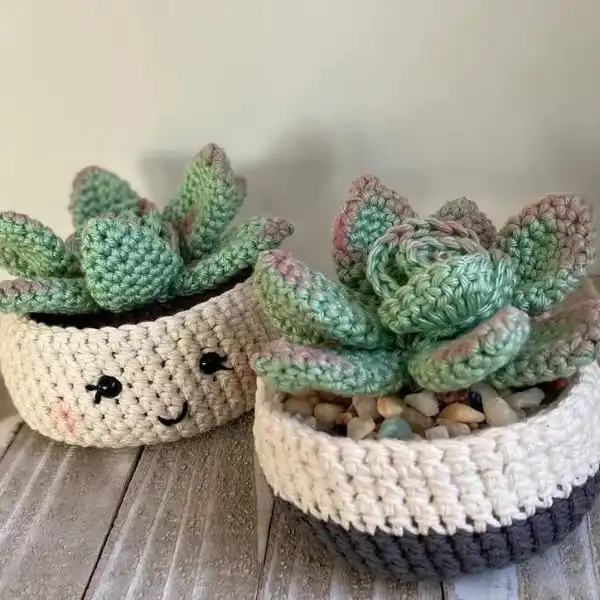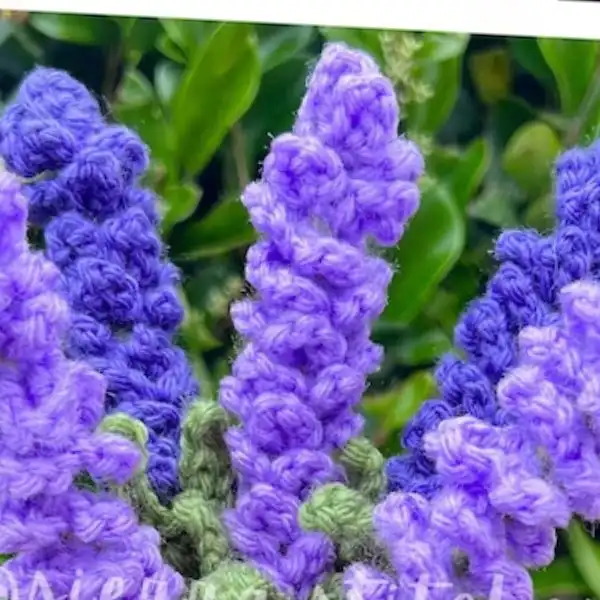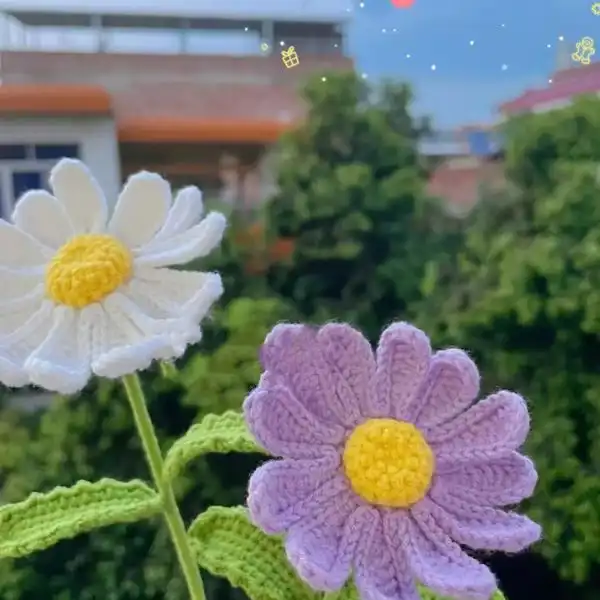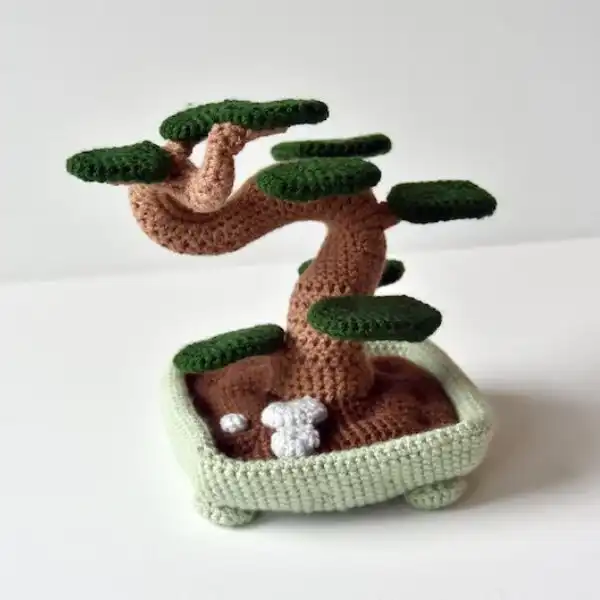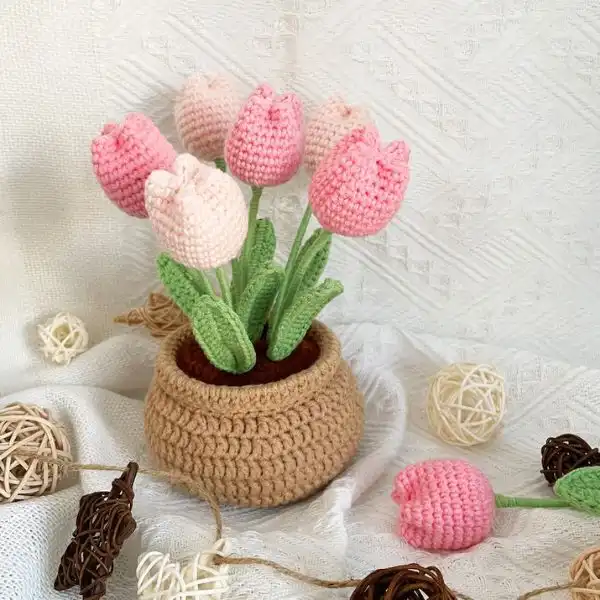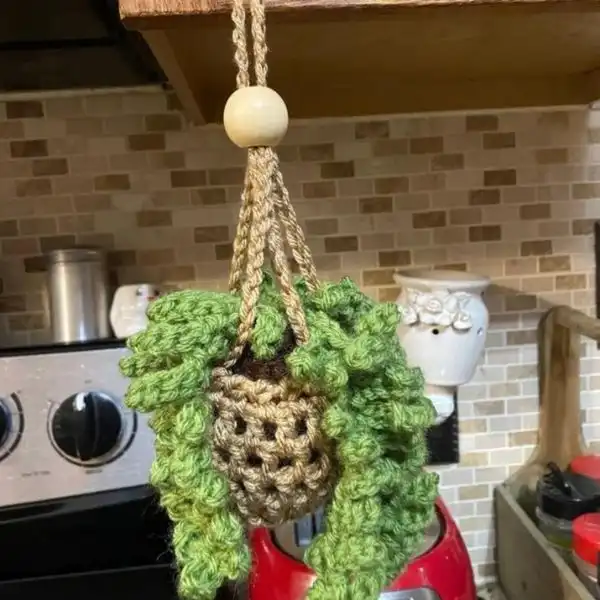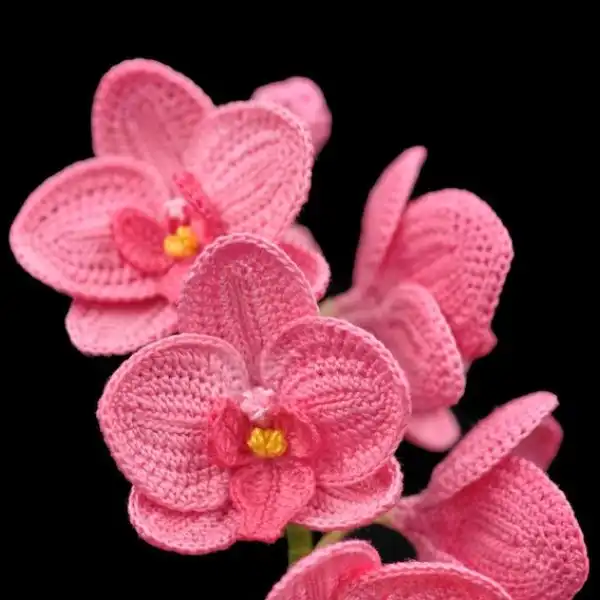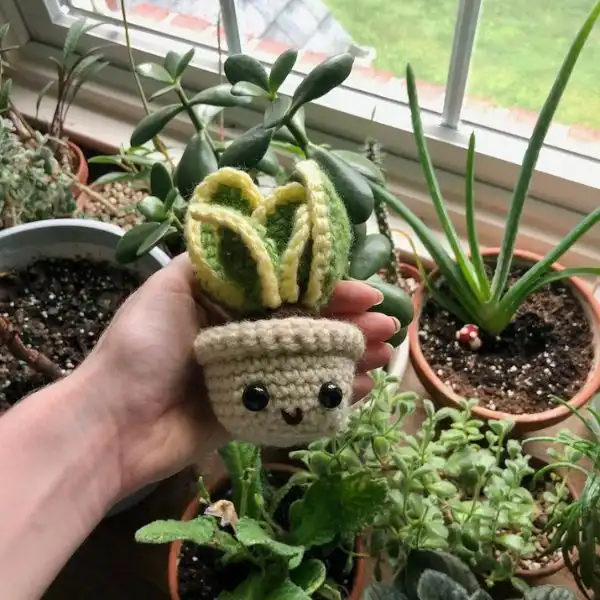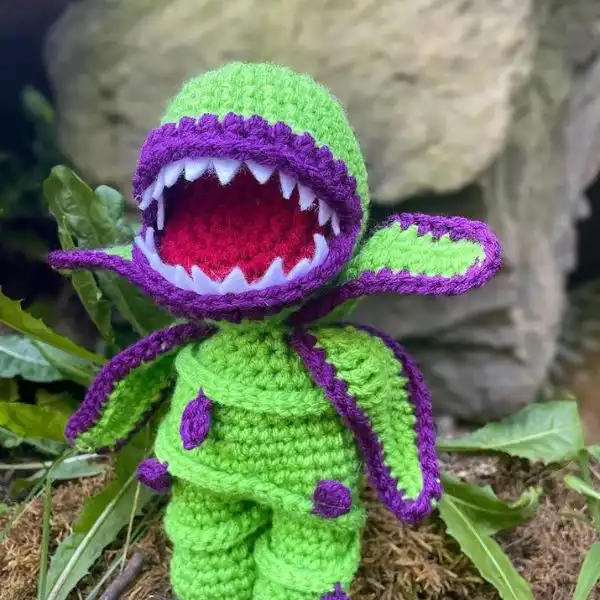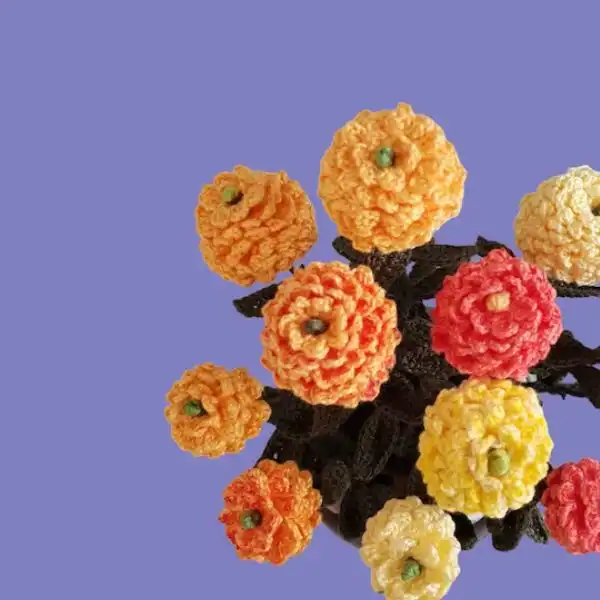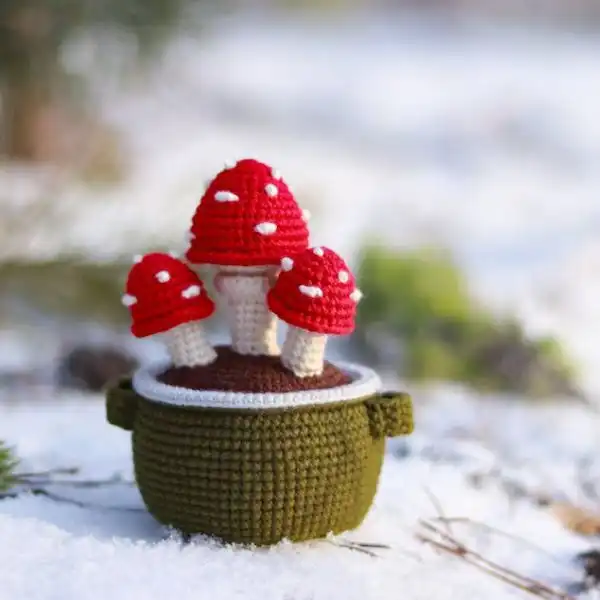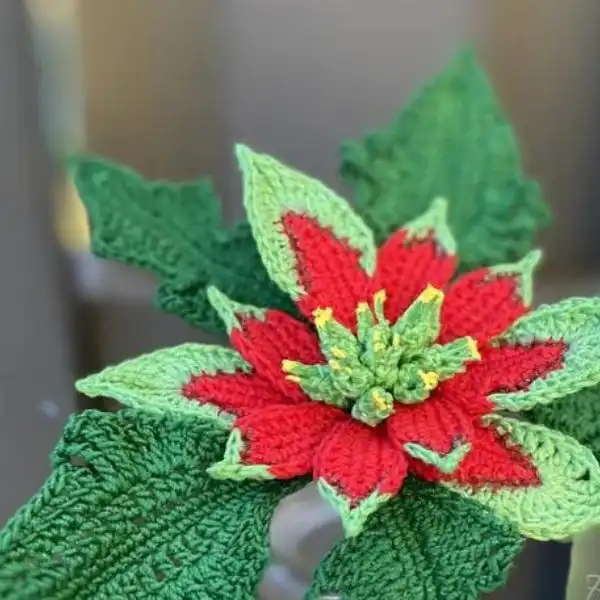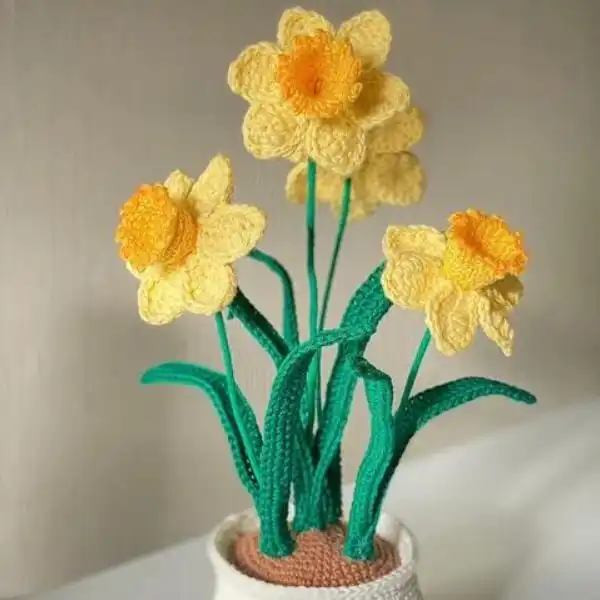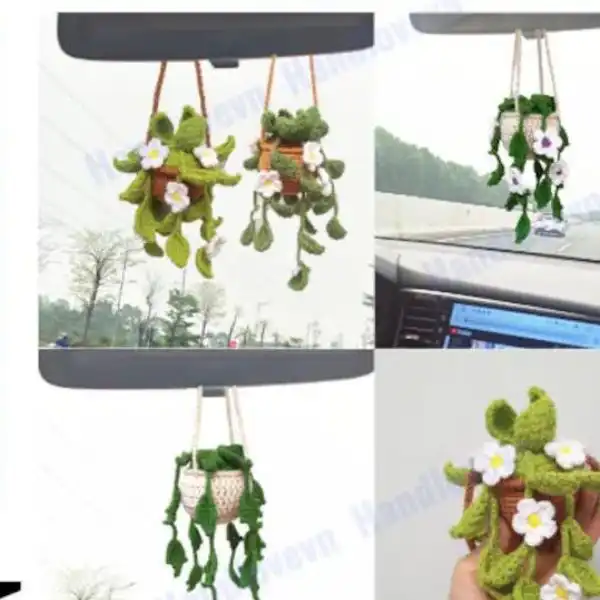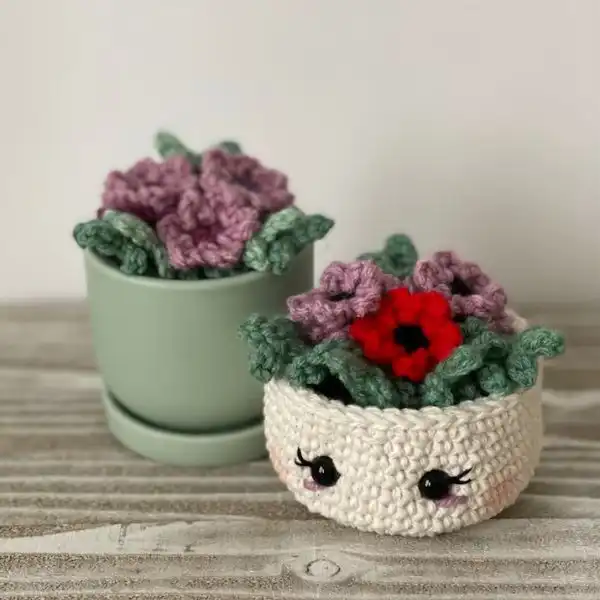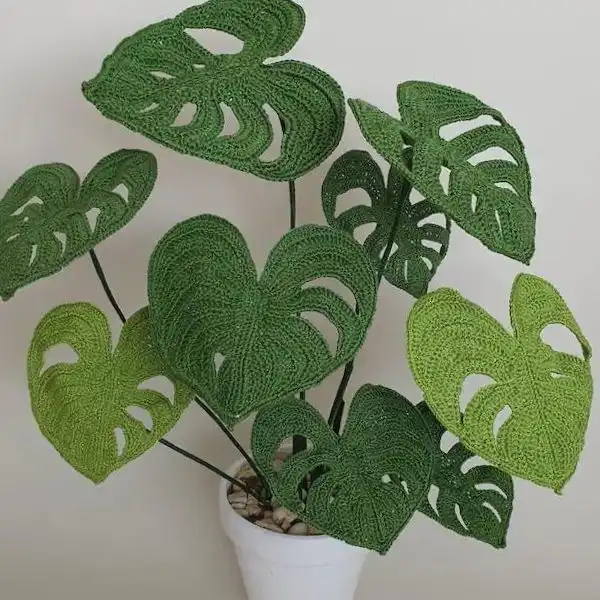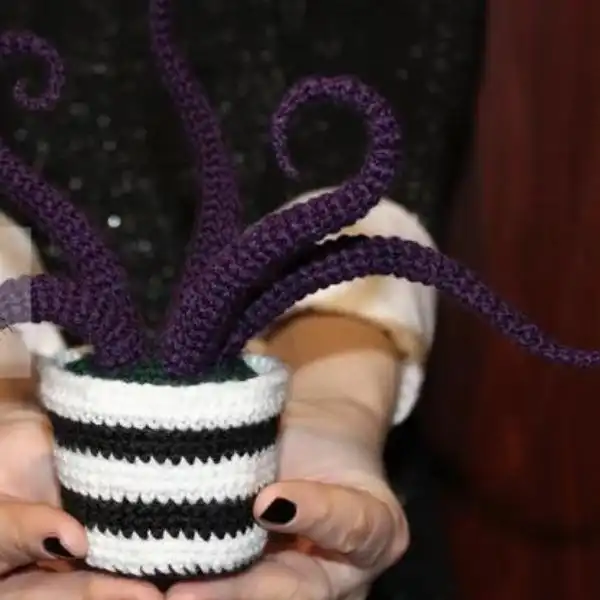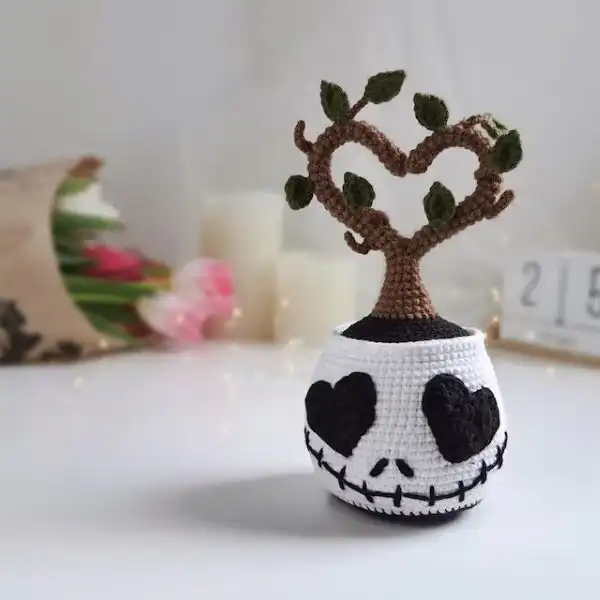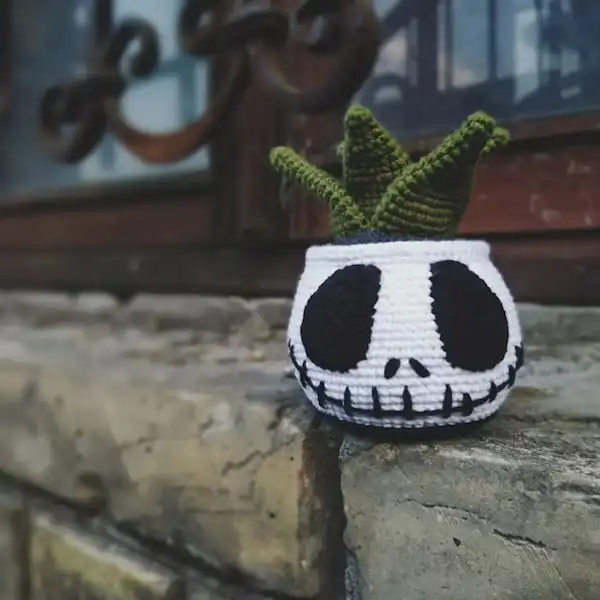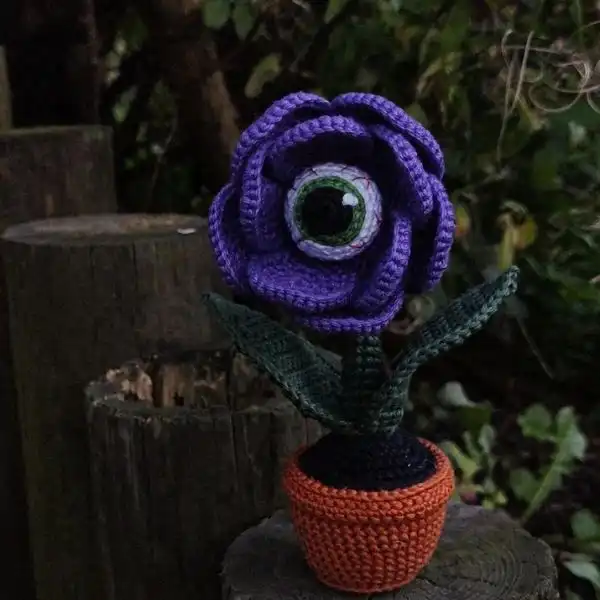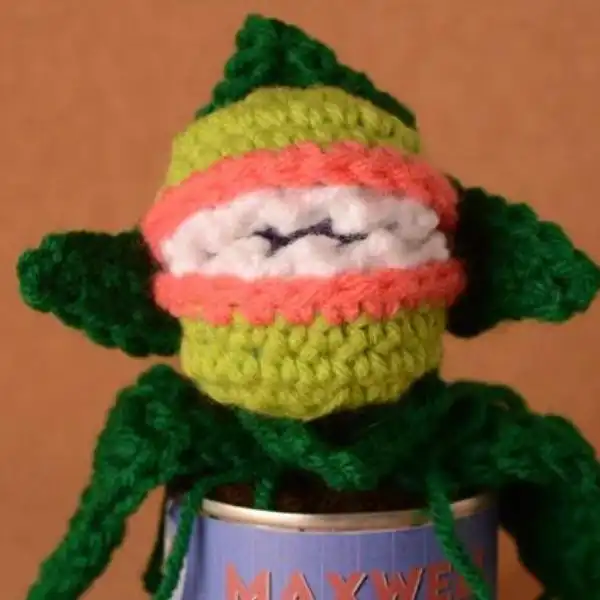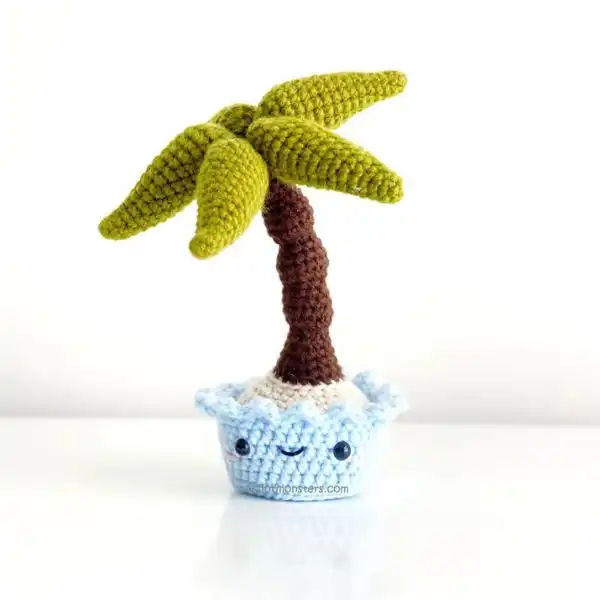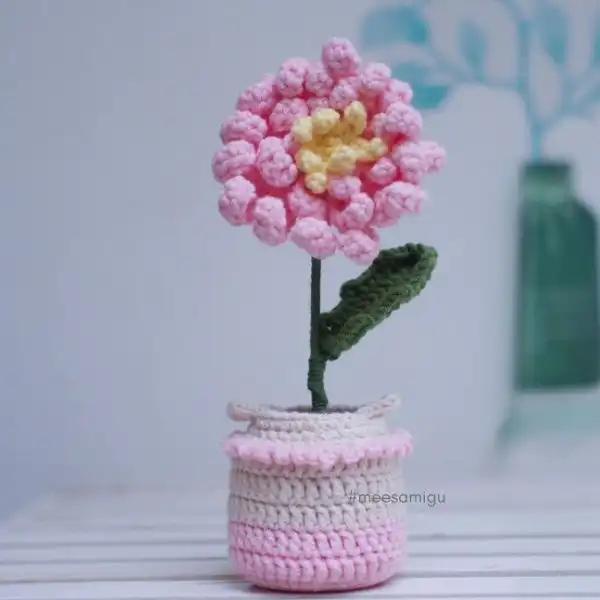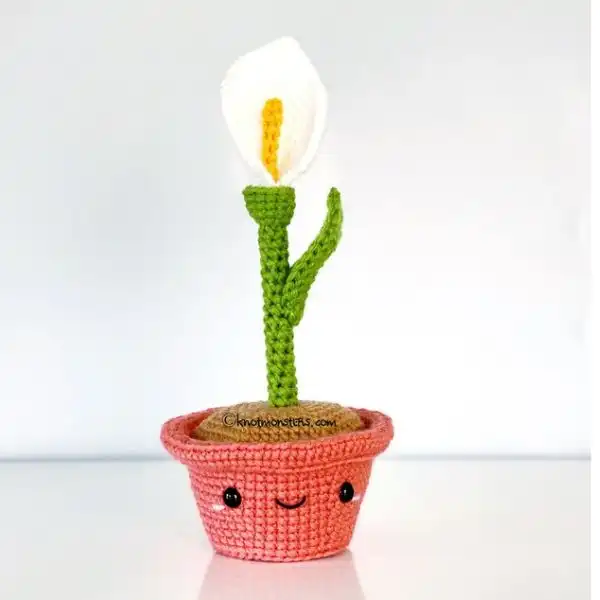Embrace your whimsical side with our whimsical patterns for crochet plants to bring greenery indoors’! In this vibrant compilation, you’ll discover a flourishing world of crochet creativity just waiting for your hook.

Dive into a colorful mix of 33 unique, wonderfully intricate crochet patterns designed to bring the magic of the outdoors into your living space. Every pattern will awaken the playful botanist within you, from trailing ivies to exotic cacti.
These charming creations require no sunlight or watering and promise to bloom perpetually, setting your indoor landscape alive with joy.
Whether you’re a seasoned crocheter or a blossoming beginner, this book offers patterns that suit every skill level.
Prepare to craft your lush crochet garden, a never-fading green oasis uniquely yours. Enrich your life with crochet greenery and let the creative journey unfurl, one whimsical plant at a time!
What Is An Amigurumi Plant?
Amigurumi is the delightful Japanese art of crafting small, knitted, or crocheted creatures and objects with an anthropomorphic charm. An Amigurumi plant is thus a miniature, three-dimensional representation of a plant created using crochet techniques.
These delightful little creations capture the essence of various plant species, from cacti and succulents to flowering beauties, all presented with a lovely, whimsical twist.
Amigurumi plants offer a charming way to bring a touch of greenery indoors without the need for sunlight or watering. Perfect for plant lovers and crochet enthusiasts, these crafted botanical wonders add a lasting splash of nature to any indoor space.
Is It Worth To Crochet Amigurumi Plants?
Crocheting Amigurumi plants is a worthwhile endeavor! Not only does it provide an opportunity to engage in a relaxing, therapeutic activity, but it also allows you to create your evergreen indoor garden.
The crochet plants require no maintenance, unlike real ones, and they bring an unending dash of charm to any space. Moreover, they’re fantastic conversation starters, making your home unique.
Whether gifting them to a plant-loving friend or decorating your space, these quirky, beautiful creations add a whimsical touch you can’t replicate. Crocheting Amigurumi plants, therefore, is an enriching experience.
RELATED: Easy Crochet Bookmark: Perfect Project for Beginners
Popular Stitches To Crochet Plant Patterns
- Chain Stitch (ch): The fundamental stitch in crochet, the chain stitch, forms the base from where other stitches emerge. It’s simple to master: make a slipknot, place it on the hook, then draw the yarn through the loop. This stitch is used to start most crochet projects and to create spaces within patterns.
- Single Crochet (sc): The single crochet stitch is the most basic and compact, often used for making dense, solid fabric. It involves inserting the hook into the stitch, yarn above (over), pulling through, then yarn above (over) again, and pulling through both loops on the hook. It’s ideal for creating the bulk of Amigurumi plants.
- Half Double Crochet (hdc): This stitch, a hybrid of single and double crochet stitches, balances tight and loose stitching. After yarning over, insert the hook into the stitch, yarn above (over), and pull through. Then, yarn above (over) again and pull through all three loops on the hook. It creates a slightly taller stitch, perfect for adding variety to your plant.
- Double Crochet (dc): The double crochet stitch is taller than the single crochet stitch, making it useful for larger plants or elements requiring more drape. The yarn above (over), insert the hook into the stitch, yarn above (over) and pull through, yarn above (over) and pull through the first two loops, then yarn above (over) again and pull through the remaining two loops.
- Slip Stitch (sl st): The slip stitch is used to join work when working in rounds, a standard method in Amigurumi. Insert the hook into the stitch, yarn above (over), and pull through both the stitch and the loop on the hook. It creates a neat, seamless join, ideal for finishing your crochet plant.
How Long Should A Crochet Plant Be?
The size of your crochet plant truly depends on personal preference and the purpose of the finished product. For instance, small Amigurumi cacti, around 3-4 inches tall, make adorable desk companions or ornaments for a miniature garden.
Medium-sized creations, around 7-10 inches, can serve as decorative accents on bookshelves. Large crochet plants, around 12-15 inches or more, could be standalone display pieces or whimsical additions to an indoor plant corner.
Consider the scale of the area where you will place the plant to determine the size. Also, remember that the size of your crochet hook and yarn weight can significantly impact the finished size of your plant.
A larger hook or thicker yarn will create a bigger piece and vice versa. If you’re mindful of these factors, your crochet plant can be as diminutive or grand as you desire!
Essential Tools & Materials
Here are the essential tools and supplies you’ll need to start crocheting your plants:
Crochet Hooks: These are the essential tools for crocheting. Hook size depends on the pattern and yarn thickness. Common sizes for Amigurumi are between 2.5mm and 3.5mm.
Yarn: You’ll need yarn in various colors based on the plants you plan to crochet. For Amigurumi, cotton yarn is often preferred due to its sturdiness and defined stitch appearance.
Fiberfill: Stuffing fills your crochet plants, giving them volume and shape.
Stitch Markers: These are useful for marking your starting point when crocheting in the round, which is common in Amigurumi.
Yarn Needle: A large, blunt-tipped needle for weaving in ends and sewing parts of the plant together.
Scissors: For cutting yarn.
Safety Eyes (Optional): If you want to add a touch of personality to your plants, you can use safety eyes to create a cute face.
Pattern: Last but not least, you’ll need a design to guide you in creating your crochet plant.
With these tools and supplies, you can start your crochet plant project!
Abbreviation Of Common Crochet Stitches And Techniques
Here’s a glossary of common crochet stitches and techniques you may come across:
- Chain (ch): The primary starting point for most crochet projects, made by drawing yarn through a loop.
- Single Crochet (sc): A compact stitch that draws yarn through two loops on the hook.
- Half Double Crochet (hdc): A mid-sized stitch made by drawing yarn through three loops on the hook.
- Double Crochet (dc): A taller stitch made by drawing yarn through two sets of two loops on the hook.
- Triple/Treble Crochet (tr): An even taller stitch made by drawing yarn through two sets of two loops and one set of three loops on the hook.
- Slip Stitch (sl st): A stitch used to join work when working in rounds or to move yarn without adding height.
- Yarn Above (over) (yo): Wrapping the yarn above (over) your crochet hook, an action done in creating stitches.
- Magic Ring/Magic Circle: A technique for starting in the round that allows you to pull the hole tight.
- Decrease (dec): Combining two or more stitches from the previous row or round to make one stitch, often used to shape Amigurumi.
- Increase (inc): Working more than one stitch into the same stitch from the previous row or round, often used to shape Amigurumi.
- Stitch (st): A loop of yarn drawn through other loops to create fabric.
- Fasten Off (FO): Cutting the yarn and pulling the tail through the last loop to secure the work.
- Work Even: Crochet without increasing or decreasing, maintaining the same number of stitches.
- Gauge: The number of stitches and rows per inch determines the project’s size.
- Join: Connect a project’s yarn, thread, or parts.
- Back Loop Only (BLO): Insert the hook only into the back loop of a stitch.
- Front Loop Only (FLO): Insert the hook only into the front loop of a stitch.
- Round (rnd): A set of stitches that ends where it began, creating a circle or cylinder.

How To Understand Crochet Stitches & Techniques?
Understanding crochet stitches and techniques primarily involves recognizing the abbreviations used in patterns and learning how to execute each stitch.
Start by familiarizing yourself with common stitch abbreviations like “ch” for chain stitch, “sc” for single crochet, and “dc” for double crochet.
Most patterns provide a legend or glossary. Next, practice these stitches using online tutorials or guides as needed. Increasing, decreasing, or working in the round might require more practice.
Also, get comfortable with reading patterns and understanding their structure.
Which Yarn Is Best For An Amigurumi Plant?
Choosing the right yarn can significantly influence your crochet plant’s texture and overall look. Here are a few types to consider:
- Cotton Yarn: This is a popular choice for crochet plants because of its sturdiness and stitch definition. It holds shapes well and comes in a wide variety of colors. It’s also easy to work with, making it an excellent choice for beginners.
- Acrylic Yarn: Acrylic is another excellent choice. It’s soft, lightweight, and available in many colors. It’s less expensive than cotton but may hold its shape less over time.
- Wool Yarn: Although less common for Amigurumi plants, wool can still be an option. It’s warm, soft, and available in a variety of textures. However, it might not be as durable or easy to care for as cotton or acrylic.
- Blended Yarn: These yarns combine the best qualities of different fibers. For example, a cotton-acrylic blend can offer the durability and stitch definition of cotton with the softness and affordability of acrylic.
How Much Yarn Do I Need To An Amigurumi Plant?
The amount of yarn you need to crochet a plant will vary greatly depending on a few factors:
- Size of the Plant: Larger crochet plants will naturally require more yarn. A small cactus may only require a skein or less, whereas a larger, more intricate plant may need several skeins.
- The complexity of the Pattern: More complex patterns, with many color changes or intricate stitch patterns, can require more yarn than simpler ones.
- Type and Thickness of Yarn: Thicker yarns or yarns with a lot of texture tend to use up more quickly than thinner, smoother yarns.
- Crochet Technique: Amigurumi (used for making crochet plants) uses more yarn than other techniques due to its dense, sturdy stitches.
Typically, your pattern will estimate the amount of yarn needed. If you’re creating your design, buying a little extra to account for any unexpected errors or adjustments is a good rule of thumb.
Is Crocheting An Amigurumi Plant Beginner-Friendly?
Yes, crocheting an Amigurumi plant can be beginner-friendly, making it an excellent project for those new to the craft. Many patterns use simple stitches, like single crochet, and techniques such as increasing and decreasing, which beginners can quickly learn.
Also, the small size of many Amigurumi plants means they can be completed relatively quickly, providing instant gratification for new crocheters. However, patience is vital, as working with smaller hooks and finer yarn may require practice.
How To Crochet A Plant?
Here is a simplified step-by-step guide on crocheting a basic Amigurumi cactus, perfect for a novice crocheter. Before you start, gather your materials:
- Green yarn.
- A crochet hook appropriate for your yarn’s weight (typically 2.5-3.5mm for Amigurumi).
- A yarn needle.
- Fiberfill stuffing.
- A small pot to place your finished cactus in.
Step 1: Start the base of the cactus.
Start by making a slipknot, then crochet six single crochet (sc) stitches into a magic circle. Pull tight to close the circle.
Step 2: Increase.
For the second round, crochet two single stitches into each of the previous round’s stitches. You should now have 12 stitches.
Step 3: Continue increasing.
For the third round, alternate between one single crochet and two single crochet stitches in each stitch from the previous round. You should have 18 stitches now.
Step 4: Start the body of the cactus.
For the next several rounds, crochet one crochet stitch from the previous round into each stitch. Repeat until your cactus is almost as tall as your pot.
Step 5: Decrease.
Start to decrease to close up the cactus. For the next round, alternate between one single crochet stitch and decrease two stitches from the previous round to one. You should now have 12 stitches.
Step 6: Stuff the cactus.
Before the hole gets too small, stuff your cactus with fiberfill. Be sure it’s firm but manageable.
Step 7: Finish off the cactus.
For the last round, decrease every two stitches from the previous round to one until you’re left with six stitches. Cut the yarn, leaving a long tail. Using your yarn needle, weave the tail through the final stitches and pull tight to close the hole. Weave in the end.
Step 8: Plant your cactus.
Lastly, place your cactus into the pot. You can secure it with a bit of hot glue if desired.
Remember, these are basic instructions. Many crochet plant patterns will introduce different stitches, techniques, and shapes, but understanding these steps will provide a solid foundation to build upon.

Types Of Crochet Plant
1. Succulent Amigurumi
This adorable crochet creation captures the essence of a miniature succulent plant. With its tiny, vibrant green leaves and charming pot, this whimsical succulent amigurumi brings any space a touch of desert charm.
Suggested Yarn: Lilac Bush - Cotton Yarn
Difficulty Level: Beginner
Yarn Weight: Worsted (4)
Crochet Hook: 3.5 mm
2. Cactus Crochet Plant
Crafted carefully, this crochet cactus plant is a delightful addition to any crochet enthusiast’s collection. Its prickly appearance is softened by soft yarn, making it a cute and safe alternative to the real thing.
Suggested Yarn: Red Heart Super Saver - Acrylic Yarn
Difficulty Level: Beginner
Yarn Weight: DK
Crochet Hook: 4.0 mm
3. Sunflower Amigurumi
Brighten up your day with this cheerful crochet sunflower amigurumi. This tiny sunflower’s sunny yellow petals and sweet smile will bring joy and warmth to any room or crochet display.
Suggested Yarn: Gazzal Baby - Cotton Yarn
Difficulty Level: Intermediate
Yarn Weight: Sport
Crochet Hook: 3.0 mm
4. Potted Lavender
Infuse your crochet haven with the soothing aroma of lavender. This lavender amigurumi features intricate purple flowers and a dainty pot, offering a calming presence and a touch of elegance.
Suggested Yarn: Borla by Omega - Acrylic Yarn
Difficulty Level: Beginner
Yarn Weight: Worsted (4)
Crochet Hook: 4.5 mm
5. Daisy Crochet Plant
Capturing the essence of a summer meadow, this crochet daisy plant radiates charm. This daisy amigurumi epitomizes simple beauty with its delicate white petals and a touch of yellow at the center.
Suggested Yarn: Lion Brand 24/7 - Cotton Yarn
Difficulty Level: Beginner
Yarn Weight: DK
Crochet Hook: 4.0 mm
6. Bonsai Tree Amigurumi
This crochet bonsai tree embodies tranquility and wisdom, channeling the ancient art of bonsai. Its miniature size and intricately designed branches create a captivating piece that adds an air of serenity to any crochet garden.
Suggested Yarn: Lotus - Bamboo Yarn
Difficulty Level: Advanced
Yarn Weight: Fingering
Crochet Hook: 2.5 mm
7. Tulip Crochet Plant
Springtime blooms eternally with this delightful crochet tulip plant. This tulip amigurumi’s vibrant colors and graceful shape evoke feelings of renewal and joy, perfect for brightening up any crochet display.
Suggested Yarn: Red Heart Super Saver - Acrylic Yarn
Difficulty Level: Beginner
Yarn Weight: Worsted (4)
Crochet Hook: 4.0 mm
8. Potted Fern Amigurumi
Embrace nature’s greenery with this crochet fern amigurumi. With its lush fronds and charming pot, this mini potted fern brings the essence of the forest into your crochet sanctuary.
Suggested Yarn: Lily Sugar n' Cream - Cotton Yarn
Difficulty Level: Intermediate
Yarn Weight: Sport
Crochet Hook: 3.0 mm
9. Orchid Crochet Plant
Grace and elegance come to life in this exquisite crochet orchid. Delicate petals and intricate details showcase the beauty of this unique flowering plant, making it a lovely addition to any crochet flower collection.
Suggested Yarn: La Mia - Bamboo Yarn
Difficulty Level: Advanced
Yarn Weight: Fingering
Crochet Hook: 2.5 mm
10. Aloe Vera Amigurumi
Harness the healing power of crochet with this adorable aloe vera amigurumi. Its spiky leaves and soothing presence make it a perfect companion for any crochet enthusiast seeking comfort and well-being.
Suggested Yarn: Lion Brand 24/7 - Cotton Yarn
Difficulty Level: Beginner
Yarn Weight: DK
Crochet Hook: 4.0 mm
11. Snake Plant Plant
Add a touch of the exotic to your crochet display with this snake plant amigurumi. Its sleek and pointed leaves create a striking visual appeal, bringing a touch of the wild indoors without any maintenance.
Suggested Yarn: TYH Supplies - Acrylic Yarn
Difficulty Level: Intermediate
Yarn Weight: Worsted (4)
Crochet Hook: 4.5 mm
12. Venus Flytrap Crochet Plant
Embrace the intriguing world of carnivorous plants with this crochet Venus flytrap. Its toothy “mouth” and vibrant colors make it a fascinating conversation piece for any crochet gardener.
Suggested Yarn: JubileeYarn - Bamboo Yarn
Difficulty Level: Advanced
Yarn Weight: Sport
Crochet Hook: 3.0 mm
13. Potted Marigold Amigurumi
Capture the essence of summer with this cheerful potted marigold amigurumi. Its warm, golden blooms and lush green leaves offer sunshine to any crochet setting.
Suggested Yarn: Lion Brand 24/7 - Cotton Yarn
Difficulty Level: Intermediate
Yarn Weight: DK
Crochet Hook: 4.0 mm
14. Crochet Vines Plant
Bring life and movement to your crochet garden with these whimsical crochet vines. They can adorn other amigurumi projects or create a hanging crochet plant, adding a touch of natural beauty to your crochet space.
Suggested Yarn: Coopay - Acrylic Yarn
Difficulty Level: Beginner
Yarn Weight: Worsted (4)
Crochet Hook: 4.5 mm
15. Mushroom Amigurumi
Venture into a fantastical realm with this adorable crochet mushroom. Its cute and quirky design makes it a delightful accent piece for any crochet nature-inspired display.
Suggested Yarn: Studio Sam - Acrylic Yarn
Difficulty Level: Beginner
Yarn Weight: DK
Crochet Hook: 4.0 mm
16. Crochet Poinsettia Plant
Embrace the holiday spirit all year round with this crochet poinsettia plant. It’s rich red petals and festive flair make it a heartwarming addition to your crochet decorations.
Suggested Yarn: JubileeYarn Delightfully - Bamboo Yarn
Difficulty Level: Advanced
Yarn Weight: Fingering
Crochet Hook: 2.5 mm
17. Potted Daffodil Amigurumi
Celebrate the arrival of spring with this charming potted daffodil amigurumi. Its bright yellow blooms and slender green leaves evoke the essence of new beginnings.
Suggested Yarn: Lily Sugar 'N Cream - Cotton Yarn
Difficulty Level: Beginner
Yarn Weight: Sport
Crochet Hook: 3.0 mm
18. Crochet Ivy Plant
Add a touch of elegance and versatility with this crochet ivy plant. Its trailing vines can be used to decorate other amigurumi projects or to create a cascading crochet plant that adds a touch of grace to any crochet display.
Suggested Yarn: La Mia - Bamboo Yarnn
Difficulty Level: Intermediate
Yarn Weight: DK
Crochet Hook: 4.0 mm
19. Potted Poppy Amigurumi
This potted poppy amigurumi symbolizes beauty and eternal sleep and is a stunning tribute to nature’s artistry. The vibrant red petals and dark centers create a mesmerizing piece for your crochet garden.
Suggested Yarn: NICEEC - Acrylic Yarn
Difficulty Level: Beginner
Yarn Weight: Worsted (4)
Crochet Hook: 4.5 mm
20. Crochet Swiss Cheese Plant
This playful Swiss cheese plant amigurumi brings a bit of the jungle into your crochet sanctuary. Its distinct holey leaves and quirky character will captivate anyone who sees it.
Suggested Yarn: Estako Royal - Cotton Yarn
Difficulty Level: Beginner
Yarn Weight: DK
Crochet Hook: 4.0 mm
21. Monster Plant
Step into the realm of imagination with this crochet monster plant. With its colorful, mischievous design, this unique amigurumi embodies creativity and fun, making it a standout addition to any crochet collection.
Suggested Yarn: Red Heart Super Saver - Acrylic Yarn
Difficulty Level: Advanced
Yarn Weight: Fingering
Crochet Hook: 2.5 mm
22. Crochet Halloween Nightmare Plant
Embrace the spooky season with this Halloween nightmare plant amigurumi. Its eerie design, with twisted vines and haunting features, will add a touch of frightful fun to your crochet decorations.
Suggested Yarn: Lion Brand Truboo - Bamboo Yarn
Difficulty Level: Advanced
Yarn Weight: Sport
Crochet Hook: 3.0 mm
23. Potted Forget-Me-Not Amigurumi
Create a sentimental and charming piece with this potted forget-me-not amigurumi. It is delicate blue flowers and tiny pot make it a heartwarming gift or a meaningful addition to your crochet garden.
Suggested Yarn: Cotton to The Core - Cotton Yarn
Difficulty Level: Beginner
Yarn Weight: DK
Crochet Hook: 4.0 mm
24. Crochet Heart Plant
Express love and affection with this crochet heart plant. Heart-shaped leaves and vibrant colors symbolize the beauty of emotions, making it a thoughtful and meaningful crochet creation.
Suggested Yarn: JumblCrafts - Acrylic Yarn
Difficulty Level: Beginner
Yarn Weight: Worsted (4)
Crochet Hook: 4.5 mm
25. Skull Succulent Plant
Combine the beauty of succulents with the allure of the macabre with this skull succulent amigurumi. Its intricate skull-shaped pot, and vibrant succulent make it a striking conversation piece for any crochet enthusiast.
Suggested Yarn: Yarn Home - Bamboo Yarn
Difficulty Level: Advanced
Yarn Weight: Fingering
Crochet Hook: 2.5 mm
26. Clarence The Peckish Plant
Meet Clarence, the mischievous peckish plant amigurumi. With his wide-eyed expression and adorable pot, he adds a touch of whimsy and humor to any crochet set.
Suggested Yarn: Red Heart Soft Baby Steps - Acrylic Yarn
Difficulty Level: Beginner
Yarn Weight: Sport
Crochet Hook: 3.0 mm
27. Halloween Eye Plant
Add an element of surprise to your Halloween decorations with this spooky Halloween eye plant amigurumi. Its watchful eyes and eerie vines make it a standout piece for the season.
Suggested Yarn: DROPS Safran - Cotton Yarn
Difficulty Level: Beginner
Yarn Weight: DK
Crochet Hook: 4.0 mm
28. Feed Me Killer Plant
Inspired by the famous plant from a classic musical, this crochet “Feed Me” killer plant amigurumi brings a touch of theatrical charm to your crochet collection. Watch out for those teeth!
Suggested Yarn: Caron Simply Soft - Acrylic Yarn
Difficulty Level: Advanced
Yarn Weight: Worsted (4)
Crochet Hook: 4.5 mm
29. Polka Dot Plant
Sprinkle some playful patterns into your crochet garden with this polka dot plant amigurumi. It’s dotted leaves and vibrant colors create a delightful and eye-catching addition to any crochet display.
Suggested Yarn: Inscraft - Acrylic Yarn
Difficulty Level: Beginner
Yarn Weight: DK
Crochet Hook: 4.0 mm
RELATED: 25 Amazing Diamond Stitch Crochet Blanket Patterns (With Pictures)
30. Palm Tree
Escape to a tropical paradise with this crochet palm tree. Its lush fronds and towering presence evoke the feeling of sandy beaches and warm ocean breezes.
Suggested Yarn: Yarn Home - Bamboo Yarn
Difficulty Level: Beginner
Yarn Weight: Worsted (4)
Crochet Hook: 4.5 mm
31. Crochet Coleus Plant
Celebrate the beauty of variegated foliage with this crochet coleus plant. Its colorful leaves and striking patterns make it a visual delight and versatile addition to your crochet garden.
32. Crochet Chrysanthemum In A Pot
Capture the essence of autumn with this crochet chrysanthemum in a pot amigurumi. Its rich fall colors and intricate petals add a touch of seasonal beauty to your crochet space.
Suggested Yarn: Pomaret - Acrylic Yarn
Difficulty Level: Beginner
Yarn Weight: DK
Crochet Hook: 4.0 mm
33. Calla Lily Flower Plant
Suggested Yarn: Lion Brand Truboo - Bamboo Yarn
Difficulty Level: Advanced
Yarn Weight: Fingering
Crochet Hook: 2.5 mm
Embrace the elegance and grace of calla lilies with this crochet calla lily plant. Its slender, white blooms and vibrant green leaves create a sophisticated and timeless crochet creation.
Tips To Avoid Crochet Mistakes
Creating a perfect crochet plant involves avoiding common crochet mistakes. Here are some tips and tricks to guide you:
Count Your Stitches: Keep track of your stitches in each round or row to ensure you follow the pattern correctly. It can prevent adding or losing stitches accidentally.
Use Stitch Markers: Especially in Amigurumi, where you often work in continuous rounds, stitch markers can help you keep track of your starting point.
Choose the Right Hook Size: Match your hook size with the yarn weight. A hook that’s too large can make stitches too loose, and a hook that’s too small can make the work too tight.
Practice Tension: Maintain consistent tension to create even stitches. Being loose and tight can affect the shape and size of the finished project.
Check Your Gauge: If the pattern provides a gauge, make a swatch and check if your stitches align. It can ensure your finished plant is the right size.
Learn to Read Patterns: Understand the abbreviations and symbols in crochet patterns. If a design seems confusing, look for an easier one or a tutorial to help break it down.
Stuff Gradually: When stuffing your crochet plant, gradually maintain the shape without distorting the stitches.
Don’t Rush: Take your time, particularly with complex patterns. Rushing often leads to mistakes.
Fix Mistakes ASAP: If you spot a mistake, correcting it as soon as possible is easier, even if it means unraveling some of your work.
Practice, Practice, Practice: The more you crochet, the more familiar you’ll become with different stitches and techniques, helping you avoid mistakes in future projects.
How To Block The Crochet Amigurumi Plant?
While blocking, such as crochet plants, isn’t always necessary for Amigurumi, it can help neaten and define your work, especially for flat pieces like crochet leaves. Here are step-by-step instructions for wet blocking, one of the most common methods:
Step 1: Prepare the Workspace
Lay out a blocking board or a few dry towels on a flat surface. Make sure this area can be undisturbed while your piece dries.
Step 2: Soak the Piece
Fill a basin with lukewarm water and mild soap if desired. Submerge your crochet piece fully and let it soak for 15-20 minutes.
Step 3: Remove Excess Water
Take the piece out of the water and gently squeeze it to remove excess water. Do not wring or twist, as this can distort the stitches.
Step 4: Arrange the Piece
Lay the piece flat on your prepared surface. Use your hands to shape it into the desired form gently. You can use rust-proof pins to hold the piece in place for intricate shaping.
Step 5: Let it Dry
Allow the piece to air dry completely. It might take up to 24 hours or more, depending on the thickness of the yarn and the size of your piece.
Step 6: Remove Pins
Once completely dry, remove any pins, and your piece should hold its shape.
Remember, blocking can change the size of your piece slightly, so it’s usually best to block before assembling your plant. Different yarns react differently to blocking, so you should test a swatch first.
Suggestions To Add A Personal Touch
Adding style and a personal touch to your crochet plant can make it unique. Here are some suggestions:
- Choose Vibrant Yarns: Give your plant a vibrant, non-traditional look by choosing bright, bold colors or variegated yarns.
- Mix Textures: Experiment with different yarn types or weights to add visual interest and tactile variety to your crochet plant. For example, a fuzzy yarn could appear like a hairy cactus.
- Embellish: Add decorative elements, like crochet flowers or vines, or non-crochet elements, such as beads, sequins, or even googly eyes!
- Make a Themed Pot: Decorate the pot to match a theme or style you like. It could be as simple as painting a specific color or as complex as creating a miniature fairy garden.
- Vary Sizes: Crochet multiple plants in various sizes and shapes to create a small indoor garden display.
- Try Different Techniques: Experiment with different crochet techniques, like tapestry for multi-colored plants or broomstick lace for a unique texture.
- Personalized Tags: Create or purchase small customized tags or labels to add to your plants. They could have your name, date, or a fun saying.
- Create a Story: Each plant could represent a family member, a special memory, or a cherished place. You could convey it through color, embellishment, or plant type.
Remember, there are no rules when it comes to adding personal touches. Let your imagination run wild, and make your crochet plant genuinely one-of-a-kind!

Wash & Care Instructions
Proper care can help ensure your crochet plant remains beautiful and lasts long. Here are some tips:
- Dusting: Regularly dust your crochet plant with a soft cloth or a feather duster. You can use a small soft-bristle brush, like a paintbrush, to get into the crevices for deeper cleaning.
- Spot Cleaning: If your plant gets a small stain, spot clean with a cloth dampened in mild soapy water. Gently rub the stain until it lifts. Rinely with a cloth dampened in clean water and let it air dry completely.
- Machine Washing: Although most crochet items can be machine washed, there may be better options for crochet plants due to their stuffing and shaping. If you do machine wash, use a gentle cycle and cold water. Place the plant in a pillowcase or laundry bag for extra protection.
- Hand Washing: Fill a basin with cool water and mild soap. Submerge the plant and gently agitate it in the water. Rinail with cool, clean water, squeeze out excess (do not wring), and reshape before leaving it to air dry.
- Drying: Never put crochet items in the dryer, which can cause shrinkage and distortion. Instead, reshape your plant and lay it flat on a towel to dry.
- Storage: If you need to store your crochet plant, keep it in a cool, dry place, away from direct sunlight, to prevent fading. Ensure it’s clean and scorched before storing it to prevent mold or mildew.
RELATED: Not All Heroes Wear Crepe – All You Need To Know About Crepe Fabric
A Quick Recap
Explore the delightful world of crochet plants, perfect for adding a touch of whimsy and greenery indoors. We’ve covered what an Amigurumi plant is, the best yarns and tools, and crucial techniques and stitches for creating them.
We’ve also delved into how to avoid common crochet mistakes, enhance the style of your plant, and take care of it for longevity.
Whether you’re a beginner or an experienced crocheter, these fun, creative, and sustainable projects can offer endless joy, serving as unique decor items or heartfelt gifts. Let’s keep on crocheting and plant some happiness!
Frequently Asked Questions
What Type Of Yarn Is Best For Crocheting Plants?
Cotton yarn is an excellent choice for crocheting plants due to its durability, stitch definition, and wide range of colors. However, you can experiment with other types of yarn for different textures and effects.
How Can I Ensure My Crochet Plant Keeps Its Shape?
Ensuring your stitches are tight and uniform, using the correct hook size, and stuffing your plant firmly yet evenly can help maintain its shape. For flat pieces, blocking might be beneficial.
Are Crocheting Plants Suitable For Beginners?
Yes, crocheting plants can be a great beginner project. Start with a simple pattern and gradually move to more complex designs as your skills improve.
How Much Yarn Will I Need For My Crochet Plant?
The amount of yarn needed depends on the size and complexity of the plant, the stitch pattern, and the yarn’s thickness. Most designs will give an estimated amount.
How Do I Clean My Crochet Plant?
Dust your plant regularly and spot clean with a damp cloth and mild soap. Depending on the yarn used, you can hand wash it, but ensure it is scorched before displaying again.
How Can I Make My Crochet Plant Unique?
Experiment with different colors, yarn textures, crochet stitches, and techniques. Adding embellishments or a theme to your pot can make your plant unique.
Why Is My Crochet Plant Not Looking Like The Pattern?
It could be due to differences in yarn weight, hook size, or tension. Make a gauge swatch if provided, and maintain consistent tension throughout your project.
- 25 Delightful Crochet Jellyfish Patterns For Sea Lovers - April 17, 2024
- 75 Free Lovely Crochet Sweater Patterns (With Pictures) - February 9, 2024
- 50 Free Crochet Blanket Patterns For A Cozy Home - January 22, 2024


